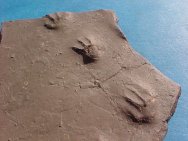Permian
Life and Fossils
 The
Permian was the last period of the Paleozoic Era. Important
evolutionary events occurred as vertebrates became increasingly
prevalent in both marine and terrestrial habitats. The early
Permian flora were a continuation from the Carboniferous, but
the middle Permian brought a major transition with lycopod trees
such as Lepidodendron and Sigillaria of the Carboniferous coal
swamps being replaced by the more advanced conifers that were
better adapted to the changing climatic conditions. Conifers
and The
Permian was the last period of the Paleozoic Era. Important
evolutionary events occurred as vertebrates became increasingly
prevalent in both marine and terrestrial habitats. The early
Permian flora were a continuation from the Carboniferous, but
the middle Permian brought a major transition with lycopod trees
such as Lepidodendron and Sigillaria of the Carboniferous coal
swamps being replaced by the more advanced conifers that were
better adapted to the changing climatic conditions. Conifers
and  cycads
spread to dominate the plant world until the Cretaceous with
the rise of the flowering plants. The Permian is famous for
the increasing dominance of tetrapods that were the first large
herbivores and carnivores, including temnospondyli, lepospondyli
and batrachosaur amphibians and sauropsids and synapsid (pelycosaurs
and therapsids) amniotes. Dimetrodon, shown below, was a member
of the pelycosaurs, or non-mammalian therapsids that had developed
by the end of the Permian, and possibly possessed by some amount
of endothermy, or, warm-bloodedness; this leads to the hypothesis
that early Triassic mammals were descended from the Permian
therapsids. The Permian concluded with the most extensive extinction
event in geological history, the Permian-Triassic ot PT extinction
event, where some 95% of marine species and 70% of terrestrial
species met extinction. The Permian began with but one trilobite
order remaining, the Proetida; the last trilobite genus, Ditomopyge,
perished at the end of the Permian cycads
spread to dominate the plant world until the Cretaceous with
the rise of the flowering plants. The Permian is famous for
the increasing dominance of tetrapods that were the first large
herbivores and carnivores, including temnospondyli, lepospondyli
and batrachosaur amphibians and sauropsids and synapsid (pelycosaurs
and therapsids) amniotes. Dimetrodon, shown below, was a member
of the pelycosaurs, or non-mammalian therapsids that had developed
by the end of the Permian, and possibly possessed by some amount
of endothermy, or, warm-bloodedness; this leads to the hypothesis
that early Triassic mammals were descended from the Permian
therapsids. The Permian concluded with the most extensive extinction
event in geological history, the Permian-Triassic ot PT extinction
event, where some 95% of marine species and 70% of terrestrial
species met extinction. The Permian began with but one trilobite
order remaining, the Proetida; the last trilobite genus, Ditomopyge,
perished at the end of the Permian
|












